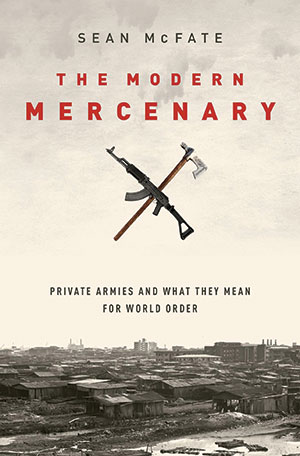Журнальный клуб Интелрос » Joint Force Quarterly » №78, 2015

At their peak, contractors comprised more than 50 percent of U.S. personnel in Iraq and Afghanistan. Furthermore, despite complaints about contractor performance, the Pentagon has stated that contractors will make up half of any future U.S. force deployments. Why? Because they work. This reality requires defense professionals to seek a deeper understanding of what contractors do and the implications for future conflict—making Sean McFate’s The Modern Mercenary a very timely book. In it, he not only carefully examines contractors, but also describes the changing international environment in which they will operate.
McFate does not claim his book covers all aspects of contracting. Rather, he focuses on the most controversial element: private military companies or, in his words, “the private sector equivalent of combat arms.” As he notes, the most disturbing aspect of the Pentagon’s increasing reliance on contractors is “the decision to outsource lethal force.” He places these companies in two categories. Those that directly apply military force are “mercenaries,” while those that train others to do so are “enterprisers.” These categories represent two distinct markets. Mercenaries exist as a free market in which each individual sells his or her services directly to the buyer, offering the means of war to anyone who can afford it. Enterprisers represent a mediated market in which the company is an arbitrator between the individual and the buyer. Essentially, the company recruits and organizes personnel to fulfill specific mission/contract requirements as defined by the buyer. For good business reasons, enterprisers are more discriminating in both the clients and tasks they accept. Unfortunately, if business demands, enterprisers can easily slip to the mercenary side of the scale.
McFate does not see mercenaries and enterprisers in the same light. Using Somalia as a case study, he argues that free market mercenaries are likely to contribute to increased instability and will not improve a state’s chances of success. In contrast, enterprisers offer a state an opportunity for success. He uses Liberia as a case study where, as a DynCorp employee, he participated in raising and training the new Liberian army. However, his argument for enterprisers is weakened by the lack of success in Iraq and Afghanistan despite the presence of dozens, if not hundreds, of enterprisers.
In one of the most interesting aspects of this intriguing work, McFate applies the concept of neo-medievalism—the belief that the world is becoming increasingly non–state-centric and multipolar—to describe the emerging global security environment. While states will remain major players, overlapping authorities and allegiances will have major impacts on how and why wars are fought and who fights them.
In this environment, McFate states, “the private military industry has a bright future. This multi-billion-dollar industry will not simply evaporate once the United States withdraws from overseas deployments such as Afghanistan. In fact, the opposite will occur: contractors will help fill the security vacuum left by US forces. . . . Already, private military companies of all stripes are seeking new opportunities in conflict zones in Africa, the Middle East, and Latin America.” He notes four trends that are driving this global expansion. First, private companies are resilient and strive to grow. They will be assisted in that growth by the next two trends: globalization and indigenization. Globalization is driving military contracting to seek overseas markets. At the same time, the numerous third country nationals who were hired by U.S. firms in Iraq and Afghanistan will take their new business and technical skills home and indigenize the market. Finally, the market will bifurcate into two major categories: mediated and free-market segments.
McFate’s meticulously researched and well-presented work concludes that “private military actors worsen security in a free market such as Somalia but increase it in a mediated market such as Liberia and under the right market conditions could even prove a powerful tool for the United Nations and others.” This reviewer found McFate’s two categories useful, but they understate the complexities of modern military contracting. The reader must understand that McFate is really describing a spectrum from pure individual mercenary to major corporate enterpriser.
McFate concludes by cautioning that the:
United States has limited regulation of and oversight over the private military industry despite employing it widely. This creates opportunities for abuse by contactors as firms subtly steer client decisions in favor of profit over policy goals, altering strategic outcomes in the process. The objectives of [private military companies] and their clients will differ, just as those of the condottieri and the provveditori did in the Middle Ages.
If he is right about the growth of military contracting—and current Defense Department policy indicates he is—any U.S. forces deployed overseas must expect to work with, and perhaps fight against, armed contractors. It is a subject that requires our professional attention, and The Modern Mercenary is a great place to start.